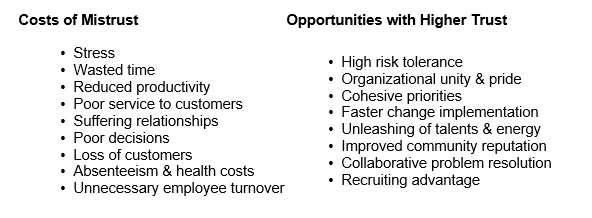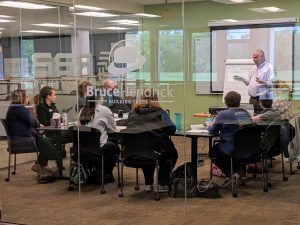Get in touch
555-555-5555
mymail@mailservice.com
Trust Issues: How One Leader Inspired a Culture of Trust
I’ve spent my entire life learning to build trust. As I grew up, my mom faced significant mental illness, so I learned first-hand how isolating life can be when trust is absent. Over time, I learned to cope with and, after much healing, eventually overcome these challenges. As a business leader, I’ve always been tuned into the telltale signs of mistrust. Frankly, I just can’t bear it when employees get stuck in these toxic patterns. For me, it’s personal.When I took the reins of leadership at RBB in 2001, my duty was to preserve the best of the culture without shying away from necessary changes. RBB was founded in 1973 by three socially-mindful engineers, so there was already a great foundation in place. Over the years, these leaders had fostered a strong culture of financial transparency, inclusion, and an intense focus on customer service.
But even with many of the pillars of a great culture in place, there was much work to be done to build trust across the company. In my short time at RBB, I had taken part in or observed too many signs of a low-trust environment. Over the years, I’ve learned that building a culture of trust begins with your personal example as a leader. The mood in our company was ripe for change – here’s the process that worked for us.
1. Know the Signs of Mistrust
I knew early on that building trust across the company would be high on my priority list. Without it, achieving other company goals would be that much more difficult. Our process started with identifying signs of mistrust in our daily culture. Through my experience with several other companies, I identified some universal signs of organizational mistrust, namely:
- Parochial thinking and behaviors
- Chronic conflict aversion
- Tacit endorsement of unhealthy team dynamics
- Disunity in priorities and ownership
- Difficult or altogether missing working relationships
- Unenthusiastic acceptance of change
- Willingness to settle for the above behaviors
2. Get Your Team to Buy In
When it comes down to it, your entire culture of trust rests on your personal example as a leader. If you want folks to trust each other in your organization, start with yourself. This process starts by building higher levels of trust with your fellow leaders and with every person you encounter. People notice. They want to emulate an effective leader.
It was time to share my observations with the team. I got everyone together and openly described the price we pay on a personal level when we don’t feel safe with our co-workers. I named the pain that many were feeling on a daily basis, but were trying to hide. I also promised them that there was a way out. It wouldn’t be easy, but it would dramatically improve our working environment.
It worked.
We had great people on our team, and they were ready and willing to make a change and turn the corner. Together, we committed to cutting down on the costs of mistrust and embracing the opportunities that would come with a healthier culture.

3. Build, Build, Build
After having the Big Talk, everyone agreed that we were paying the high costs of mistrust and were eager to see the opportunities above materialize. With the team on board, I volunteered to teach a two-day workshop on interpersonal communications for everyone in the company, with about a dozen employees at a time.
It took about two years to get everyone through the initial workshop. When necessary, we conducted follow-up sessions and individual coaching sessions, too. In some cases, things got worse before they got better. We were finally dealing with unacceptable behaviors and pent-up frustrations. In fact, in two cases so much earlier damage had been done that two individuals parted ways with RBB. They quickly realized how committed we really were to open, honest, and constructive trust building, and it just wasn’t for them. While unfortunate, these exits actually accelerated our progress.
After four years dedicated to trust-building efforts, the transformation was palpable. The vast majority of relationships in the company were free, open, and mutually trusting. Our interpersonal stress became issues-based and temporary. We were dealing with what I call the “icky” stuff without taking things personally. We could move on from conflicts quickly. Decisions became easier, better, and less risky. Customers felt it and they told us so. Company performance improved significantly. And when people acted in ways that eroded trust, they stood out like sore thumbs.
Are we a conflict-free company? Of course not. But we trust each other enough to talk things through openly and in the spirit of unity, allowing us to act like teammates, not adversaries, even in stressful conditions.
4. Maintain Your Culture Every Day
As every values-driven leader well knows, our work is never truly finished. A culture of trust is only sustainable through daily care and feeding by every person in the organization. At RBB, there are many aspects to how we maintain our culture, in small yet significant ways:
- Never lie, period. If something must remain private, explain why.
- Always err on the side of transparency – this requires vulnerability.
- Share bad news fast: without excuse, shame, or grudge.
- Resolve issues with the ‘source’ person: in private, face-to-face, and with respect.
- Demonstrate willingness to extend trust to others.
- When you fall short, and you will… own it.
- Specify healthy behaviors that everyone should live by ( download RBB’s here )
After four years of hard work, living out our culture of trust had become so natural that I opened another business in 2008: Building Trust, LLC , a firm committed to spreading the “trust wealth” to other businesses and organizations. I encourage you to take the pulse of your current environment and evaluate the trust-related behaviors in play within your organization. And if you need any help along the way, feel free to contact me personally.
This blog post was originally featured on the Small Giants Community Blog.
I’ll be taking to the stage at #SGCSummit2017 in Detroit May 16 – 19, 2017 alongside a lineup of game-changing business leaders from all walks of life.

Bruce Hendrick founded Building Trust in 2008 to help clients feel less isolated in their careers and lives, allowing them to cut through the distractions, build on unique talents, forge stronger relationships, and work more effectively with less stress.
Services
All Rights Reserved | Building Trust, LLC. All Rights Reserved


